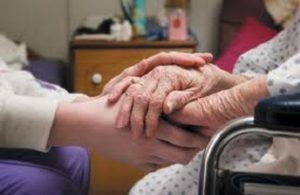“There’s no place like home for the holidays”. Surrounded by family and friends, either safely in person or via FaceTime or Zoom, with COVID still spreading rampant. Sharing memories, celebrating the Holiday Season, sharing meals, and spending time with loved ones is what its all about.
While “Last Christmas” was completely different, the same premise is still here- keeping loved ones at home. Most people put off a hospice referral until after the holidays when they should do the opposite. Hospice care can keep loved ones at home and in the thick of all the family activities while their pain and symptoms are expertly managed and improving quality of life. Early referral and admission to hospice care allows patients to benefit more from hospice care, spend more time with loved ones at home, and allows the family to benefit more from hospice care.

Care that keeps loved ones at home
Hospice care is provided wherever the patient calls home. Hospice care allows patients to have a “Wonderful Christmastime” by having all types of pain managed in the home setting- physical, financial, psychological, social, and spiritual. Hospice does not hasten death, and many studies have shown it can prolong a patient’s life when referred early enough due to increase in quality of life. Having access to a nurse 24 hours per day, every day, can give you a “Silent Night” at home without trips to the Emergency Room. This means if the patient is experiencing symptoms or a fall in the middle of the night, one call to (270) 826-2326 will have a nurse to the house controlling the symptoms and keeping the patient comfortably at home.
Care that alleviates stress
The holiday season is stressful enough. Hospice care can help reduce some of the stressors by keeping your loved one clean and comfortable to improve quality of life. You might think “Santa Claus is Coming to Town” but it’s really your Hospice Care Aide coming to assist with basic hygiene tasks such as bathing to keep your loved one feeling clean! Volunteers can provide companionship and respite care for caregivers, which helps reduce stress while “Christmas Wrapping”, cooking, and placing presents “Underneath the Tree”.
Care that comforts
Once admitted to hospice care, an interdisciplinary team surrounds the patient to treat all symptoms. The interdisciplinary team at St. Anthony’s consists of nurses, chaplains, social workers, volunteers, aides, a nurse practitioner, the patient’s primary care physician, and our medical directors. The team not only supports the patient but supports the patient’s family. They can provide emotional support and education to family members to understand the patient’s disease process and cope with the physical and mental changes that occur to the patient throughout the process. Our care team’s goal is to have all symptoms controlled thus increasing quality of life and ensuring “It’s the Most Wonderful Time of the Year.”
Care that continues
If your loved one has symptoms that can’t be managed at home, St. Anthony’s Hospice has an inpatient unit- the Lucy Smith King Care Center. We offer different levels of care at the Lucy Smith King Care Center to meet the needs of our patients. These levels of care include general inpatient, respite, and residential. General inpatient care is for hospice patients who are experiencing uncontrolled symptoms such as uncontrolled pain, nausea and vomiting, complex wound care, uncontrolled seizures, etc. Respite care is offered for caregivers who need a break to attend an event, staycation, or vacation for up to 5 days. Residential care is when a patient chooses to live at Lucy Smith King Care Center for a room and board rate of $275/day. Even though “Baby It’s Cold Outside,” we want to ensure your loved one is receiving the warmest and highest level of care, just as we would give our own family.
With the holidays among us, we always want to make certain that our patients receive the expert care that St. Anthony’s Hospice is known for. Our clinicians are experts in pain and symptom management that will keep patients comfortable and “Rocking Around the Christmas Tree” with their loved ones. Please give us a call at (270) 826-2326 to refer a loved one or with any questions. We would be happy to help because “(There’s No Place Like) Home for the Holidays.”
By the way, how many song titles did you pick up on?









